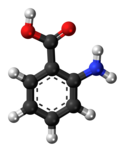| |||
| Names | |||
|---|---|---|---|
| Preferred IUPAC name
2-Aminobenzoic acid[1] | |||
| Systematic IUPAC name
2-Aminobenzenecarboxylic acid | |||
Other names
| |||
| Identifiers | |||
3D model (JSmol)
|
|||
| 3DMet | |||
| 471803 | |||
| ChEBI | |||
| ChEMBL | |||
| ChemSpider | |||
| DrugBank | |||
| ECHA InfoCard | 100.003.898 | ||
| EC Number |
| ||
| 3397 | |||
| KEGG | |||
PubChem CID
|
|||
| RTECS number |
| ||
| UNII | |||
CompTox Dashboard (EPA)
|
|||
| |||
| |||
| Properties | |||
| C7H7NO2 | |||
| Molar mass | 137.138 g·mol−1 | ||
| Appearance | white or yellow solid | ||
| Odor | odorless | ||
| Density | 1.412 g/cm3 | ||
| Melting point | 146 to 148 °C (295 to 298 °F; 419 to 421 K)[3] | ||
| Boiling point | 200 °C (392 °F; 473 K) (sublimes) | ||
| 0.572 g/100 mL (25 °C) | |||
| Solubility | very soluble in chloroform, pyridine soluble in ethanol, ether, ethyl ether slightly soluble in trifluoroacetic acid, benzene | ||
| log P | 1.21 | ||
| Vapor pressure | 0.1 Pa (52.6 °C) | ||
| Acidity (pKa) |
| ||
| -77.18·10−6 cm3/mol | |||
Refractive index (nD)
|
1.578 (144 °C) | ||
| Thermochemistry | |||
Std enthalpy of
formation (ΔfH⦵298) |
-380.4 KJ/mol | ||
| Hazards | |||
| GHS labelling: | |||
 
| |||
| Danger | |||
| H318, H319 | |||
| P264, P280, P305+P351+P338, P310, P337+P313 | |||
| NFPA 704 (fire diamond) | |||
| Flash point | > 150 °C (302 °F; 423 K) | ||
| > 530 °C (986 °F; 803 K) | |||
| Lethal dose or concentration (LD, LC): | |||
LD50 (median dose)
|
1400 mg/kg (oral, rat) | ||
| Safety data sheet (SDS) | External MSDS | ||
| Legal status | |||
Except where otherwise noted, data are given for materials in their standard state (at 25 °C [77 °F], 100 kPa).
| |||
Anthranilic acid is an aromatic acid with the formula C6H4(NH2)(CO2H) and has a sweetish taste.[5][6][7] The molecule consists of a benzene ring, ortho-substituted with a carboxylic acid and an amine. As a result of containing both acidic and basic functional groups, the compound is amphoteric. Anthranilic acid is a white solid when pure, although commercial samples may appear yellow. The anion [C6H4(NH2)(CO2)]−, obtained by the deprotonation of anthranilic acid, is called anthranilate. Anthranilic acid was once thought to be a vitamin and was referred to as vitamin L1 in that context, but it is now known to be non-essential in human nutrition.[8]
- ^ "Front Matter". Nomenclature of Organic Chemistry : IUPAC Recommendations and Preferred Names 2013 (Blue Book). Cambridge: The Royal Society of Chemistry. 2014. p. 748. doi:10.1039/9781849733069-FP001. ISBN 978-0-85404-182-4.
- ^ Haynes, William M., ed. (2016). CRC Handbook of Chemistry and Physics (97th ed.). CRC Press. pp. 5–89. ISBN 978-1498754286.
- ^ IPCS
- ^ Anvisa (2023-03-31). "RDC Nº 784 - Listas de Substâncias Entorpecentes, Psicotrópicas, Precursoras e Outras sob Controle Especial" [Collegiate Board Resolution No. 784 - Lists of Narcotic, Psychotropic, Precursor, and Other Substances under Special Control] (in Brazilian Portuguese). Diário Oficial da União (published 2023-04-04). Archived from the original on 2023-08-03. Retrieved 2023-08-15.
- ^ Acton, Q. Ashton (2013). Aminobenzoic Acids—Advances in Research and Application (2013 ed.). Atlanta: ScholarlyEditions. p. 23. ISBN 9781481684842 – via Google Books.
- ^ Hardy, Mark R. (1997). "Glycan Labeling with the Flurophores 2-Aminobenzamide and Antranilic Acid". In Townsend, R. Reid; Hotchkiss, Arland T. Jr. (eds.). Techniques in Glycobiology. Marcel Dekker, Inc. p. 360. ISBN 9780824798222 – via Google Books.
- ^ The Merck Index, 10th Ed. (1983), p.62., Rahway: Merck & Co.
- ^ Davidson, Michael W. (2004). "Anthranilic Acid (Vitamin L)]". Florida State University. Retrieved November 20, 2019.


